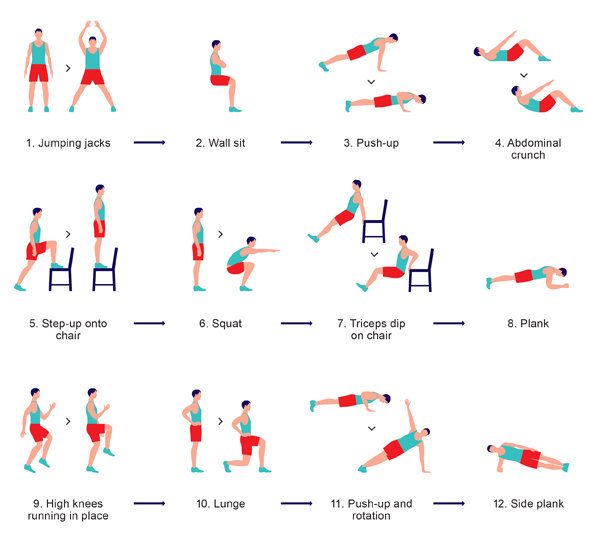Executive High Intensity Sub 10 Minute Training
At the Human Performance Institute, Division of Wellness and Prevention, Inc., in Orlando, FL, our clients are high-performing professionals from a variety of industries. These men and women face incessant demands on their time, along with the pressure to perform at high levels and balance their careers and personal lives.
As the hectic pace of today’s corporate and entrepreneurial world continues to eat into the amount of time we have for exercise, high intensity cross training (HICT) workouts offer a good option to help busy individuals improve their health and recover from stress via exercise.
The collective scientific evidence indicates that high intensity circuit training (HICT) is an efficient means of exercise to help decrease body fat, improve insulin sensitivity, and improve V˙O2max and muscular fitness.
A HICT Workout That Combines Synergetically with Brain Training: The 7 Minute Workout
A 7 minute, all-round ‘high intensity circuit training’ workout has recently been show-cased in the New York Times (article here). It is based on sound scientific principles. I have been doing it consistently for 3 months now.
“There’s very good evidence” that high-intensity interval training provides “many of the fitness benefits of prolonged endurance training but in much less time,” says Chris Jordan, the director of exercise physiology at the Human Performance Institute in Orlando, Fla., and co-author of the new article. To quote from the New York Times:
Work by scientists at McMaster University in Hamilton, Ontario, and other institutions shows, for instance, that even a few minutes of training at an intensity approaching your maximum capacity produces molecular changes within muscles comparable to those of several hours of running or bike riding.
Interval training, though, requires intervals; the extremely intense activity must be intermingled with brief periods of recovery. In the program outlined by Mr. Jordan and his colleagues, this recovery is provided in part by a 10-second rest between exercises. But even more, he says, it’s accomplished by alternating an exercise that emphasizes the large muscles in the upper body with those in the lower body.
The 7 minute workout is shown below. There are 12 exercises. Exercises are performed for 30 seconds, with 10 seconds of transition time between bouts. Total time for the entire circuit workout is approximately 7 minutes. The circuit can be repeated 2 to 3 times, depending on time.
1. Jumping jacks Total body
2. Wall sit Lower body
3. Push-up Upper body
4. Abdominal crunch Core
5. Step-up onto chair Total body
6. Squat Lower body
7. Triceps dip on chair Upper body
8. Plank Core
9. High knees/running in place Total body
10. Lunge Lower body
11. Push-up and rotation Upper body
12. Side plank Core
The full text of the original scientific journal article for the 7 minute workout can be found here.
Recommended Total Bio-Cognitive Workout
For maximum brain training effectiveness, I recommend combining the 7 minute workout with i3 Mindware. Both should be done at least 4-5 days per week. I train with the 7 minute workout in the morning and working memory training in the evening, Monday to Friday.
Combining a regular physical workout with cognitive training should have a synergistic effect that enhances not only your cognitive performance training but also your physical fitness training. This is the total bio-cognitive performance workout.
You could consider combining this 2-way synergy training with nootropics to maximize results.
The Science: Benefits of regular workouts for neuroplasticity and cognitive performance
Aerobic exercise promotes rapid and profound alterations in the brain. Depending upon the pattern and duration of exercise, these changes in the brain may extend beyond traditional motor areas to brain areas normally linked to learning, cognition, and emotion.
Neuroplasticity – also known as brain plasticity – refers to adaptive changes in neural pathways (long range connections between neurons) and synapses. Synapses are the connecting points between individual neurons – the processing units in the brain. This kind of rewiring allows for learning, memory and skill-acquisition.
Evidence from both human and animal studies demonstrates that working out induces neuroplasticity of brain structures that are also involved in important ‘executive’ cognitive functions such as attention control, as well as processing speed and memory. These cognitive functions are building blocks of general intelligence and IQ level.
The research reviewed here in Neuroscience & Biobehavioral Reviews on the exercise-cognition link comes to three conclusions:
-
Physical activity has beneficial effects on executive functions and memory in humans
-
Neural systems that are known to have a high capacity for neuroplasticity change appear to be the first that are enhanced by exercise.
-
Maintenance of cardiovascular fitness is necessary for long-term effects on cognition.
Synergy between exercise and cognitive training
Another important conclusion from IQ training purposes from the scientific literature is that “combining physical and cognitive training might result in a mutual enhancement of both interventions” (reference). This is the idea of a synergy between brain training and fitness training: there is an interaction that is more effective for both physical and cognitive performance, than the effect of each considered independently.



